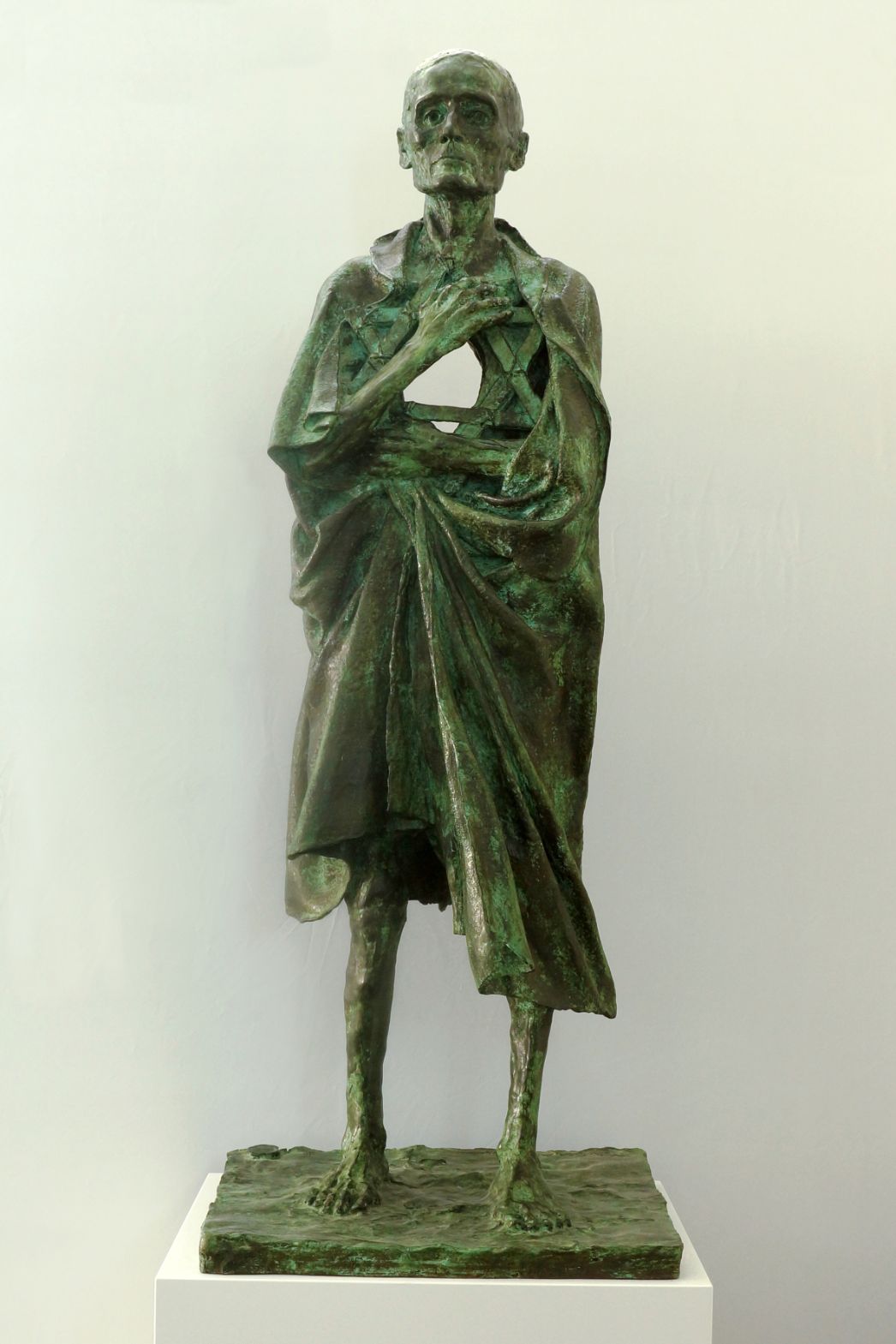
“I decided to depict a Jew, standing upright, staggering with weakness. In his arms he holds a Magen David, the symbol of the Jewish nation, the only source of pride that has remained to him. The great hole in his chest is the gaping wound of his people. … Wrapped in a blanket, his head bare, my figure was supposed to serve as a reminder of the men they called “Muselmänner”. The deportees at death’s door—will he survive, emigrate, fight for Israel’s independence like others, or die?”
The painter and graphic artist Walter Spitzer, a former inmate of the Buchenwald concentration camp and resident of Paris, exhibited his design for a Jewish monument at the Buchenwald Memorial in 1993. The competition jury awarded his figure Muselmann an honorary prize. In the jury’s estimation, it was “an especially powerful depiction of a figure of a deported Jew, who, in the presence of death, maintains his upright stance and his dignity”. The sculpture has been on view as a bronze cast in the art exhibition of the Buchenwald Memorial since 1995.
Inspired by the work for Buchenwald, Spitzer carried out a design for another monument as well: a figural group in memory of the French Jews rounded up in the “Vel d’Hiver” in Paris in 1942 and deported to the extermination camps. That monument was dedicated in 1994 by François Mitterrand, then the president of France. “The Shoah is the largest crime against humanity. In a thousand, in two thousand years, people—not only Jews, but also Christians—will remember it as a great disaster. The Shoah evolved from the Western Christian civilization and was only possible through it.” This was Walter Spitzer’s conviction, and the wellspring of his artistic creativity.
Biography
Walter Spitzer was born in the Upper Silesian town of Cieszyn on 14 June 1927, the son of a middle-class Jewish family, and attended a German school. After the war began, Cieszyn was occupied by the Wehrmacht and its Jewish population forced to move to a ghetto near Katowice. When the Nazis destroyed the ghetto in June 1943, Walter Spitzer was deported to Auschwitz. His mother was shot to death the same day. From Auschwitz, the sixteen-year-old was transferred to a Jewish forced labour camp in Blechhammer (Blachownia-Sląska), where the inmates were put to work under inhumane conditions building chemical hydration plants.
The drawings Spitzer made for guards and fellow inmates during breaks became a means of survival. On 21 January 1945, the SS forced the inmates onto a death march to the Gross-Rosen concentration camp, located 300 kilometres away. From there they were transported to the Buchenwald concentration camp by rail. The inmates “evacuated” from the camps in the east were subjected to mass illness and death in the “Little Camp” of the Buchenwald concentration camp.
Walter Spitzer’s experience and routine in the drawing medium saved his life. He portrayed inmate functionaries and promised to record his memories later in drawings. In return, they enabled him and a friend to leave the place of dying and death that was the “Little Camp”. One day before the liberation, Spitzer was again sent off on a death march, but managed to flee near Jena. He returned to the meanwhile liberated Buchenwald camp with a unit of the 3rd U.S. Army Signal Corps. He later accompanied the American troops to Southern Germany, Austria, and finally Paris, where he arrived on 26 June 1945. Now he was able to realize a childhood dream—to study at the École des Beaux Arts.
In the decades that followed he produced a multifaceted artistic oeuvre. In 1955 he produced engravings of the drawings he had executed immediately after his liberation from the concentration camp. He designed stage decors, illustrated Early French literature, painted, and worked in the sculpture medium. In 1995, he opened an exhibition of his works entitled “50 Jahre Befreiung des KZ Buchenwald. 50 Jahre Arbeit” (50 Years since the Liberation of the Buchenwald Concentration Camp: 50 Years of Work) at the Buchenwald Memorial. Walter Spitzer died in Paris on 13 April 2021.


